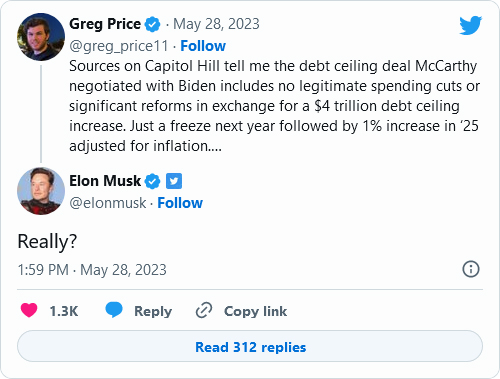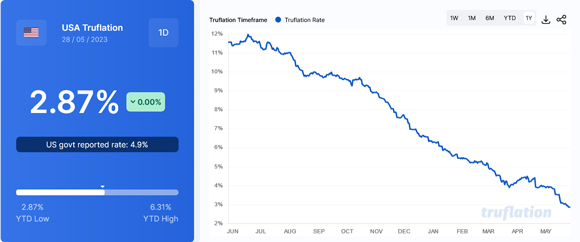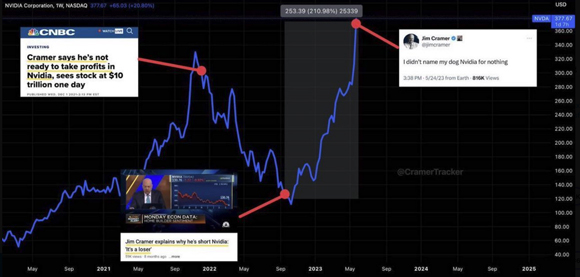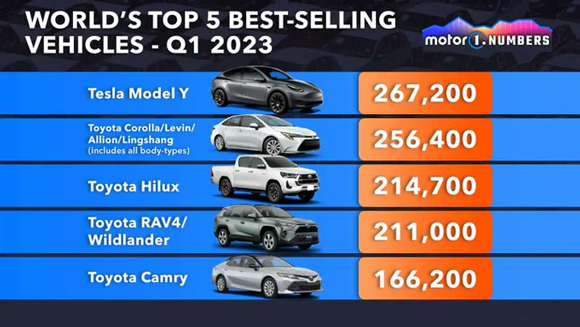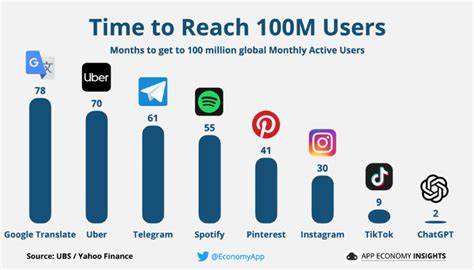Well, it seems a deal has been done over the weekend.
As reported:
|
|
| Source: Twitter |
Elon Musk expressed surprise at the deal, which seems to be a bit of a capitulation from the conservatives.
Though, senior Republican lawmaker Speaker Kevin McCarthy pointed out that this deal freezes any new spending or taxes.
But when you cut out the spin, the fact is, US debt is set to keep surging higher.
I suppose when you’re already US$31 trillion in the hole, what does another US$4 trillion matter?
Incidentally, it was no surprise — to me at least — that Bitcoin [BTC] jumped 2% on news of the deal on Sunday.
Moments like this really highlight the absolute scarcity value of bitcoin compared to unlimited fiat money printing.
Make no mistake, US debt is only going to grow…but the can can’t be kicked down the road forever.
A day of reckoning will come, and Bitcoin is the only non-captured ‘insurance’ policy for when the US actually does default.
Anyway, the deal isn’t quite a ‘lock in’ yet and will still have to pass through the US legislative system.
You never know, there could be more surprises still to come.
But with this drama potentially behind us (until the pantomime plays out again in 2025), market focus will return to central banks and future interest rate rises.
On that note, revised GDP figures out of Germany late last week showed the powerhouse of Europe is already in a recession.
What’s more, according to unofficial sources, US inflation is falling fast.
As you can see below, they’ve now got a ‘2’ in front of them — that’s within the 2–3% central bank target:
|
|
| Source: Truflation |
Let’s add it all up…
Debt ceiling issue resolved — check.
Inflation falling fast — check.
Global economies slowing down fast — check.
This suggests we may be close to the end of central bank interest rates rises. Indeed, we may even see a pivot the other way this year.
You know what all this is good for?
Tech stocks…
Greg hasn’t accounted for this!
As you know, the big story of last week was the surge in the stock price of chip company Nvidia [NASDAQ:NVDA].
It surged 24% in just one day.
Make no mistake, this is an absolutely huge move for such a large stock. I mean, we’re not talking some small-cap being pumped up by Reddit day traders!
I heard someone on Bloomberg called it the biggest one-day move ever for a large-cap stock.
I’m not sure if that’s true or not, but it must be up there.
As my colleague Ryan Clarkson-Ledward pointed out on Friday, the driver behind the immense move was an earnings surprise based on artificial intelligence (AI) chip demand.
He also noted this has led to many debates about whether AI is already a bubble or if it’s still the start of a new bull run?
We’re having these discussions internally too.
My colleague and editorial director, Greg Canavan, expressed some doubt in an email saying on Nvidia:
‘But with earnings per share growth forecasts of 260%, 15%, and 23% in next three years, you have to say its priced in.
‘But what’s not priced in?
‘That’s going to be my catchphrase from now on. For everything.’
I responded with a tongue-in-cheek (well, half tongue in cheek!) comment on the possibility of AI driving intergalactic commerce.
To which Greg replied:
‘Yeah Ryan, but what’s not priced in?’
Me: ‘Intergalactic Commerce.’
Greg: ‘…’
[Editor’s note: Not coincidentally, Greg and my other colleague Kiryll launched a brand-new podcast last Friday called What’s Not Priced In. I caught the first episode and it was fantastic. Already, I can see it’s set to be an indispensable part of my own investing research. And it’s free! Catch the first episode here.]
Look, to some degree, Greg is likely to be right in the short term.
Mini bubbles on waves of hype tend to develop with any new technological breakthrough.
And on Nvidia, in particular, I can see no better reason to be wary than this graphic from Inverse Cramer — a Twitter account that does the exact opposite of what popular CNBC talking head Jim Cramer says:
|
|
| Source: Twitter |
Where I differ from Greg in my approach to this is that I think there’s something tangible of value behind the AI hype.
And in my experience, more traditional investors find it very hard to account for the possibility of exponential growth.
The truth is, when you invest in new technology trends, you have to be able to straddle both the optimistic and sceptical viewpoints in equal measure.
Take this classic example…
It reminds me of Tesla and the start of the EV trend
I remember when Tesla first came onto the scene around 2013/14.
For years it — and the idea of electric cars in general — was hated on by mainstream analysts on an almost daily basis.
‘Never going to happen!’ they’d scoff.
Today, we’re here:
|
|
| Source: Motor1.com |
My point is, new tech is almost always underestimated in the long term, even if stock prices tend to get ahead of themselves in the short term.
Maybe Nvidia’s move is a bit of that?
In saying that, there was real money behind this move too.
The surge was propelled by surprise earnings already coming from the AI wave. This wasn’t just based on a hyped-up narrative.
And what the sceptics perhaps fail to see is the sheer pace of this trend.
I mean, ChatGPT — the AI chatbot that triggered the renewed interest in AI — reached 100 million users in just two months.
Compare that against other game-changing tech products:
|
|
| Source: Business Insider |
But the real reason this is so exciting is that unlike, say, TikTok (which took nine months to hit 100 million users), AI isn’t a product but a technology.
It’s a technology that has applications across nearly every single industry.
A quick nuance to be aware of here though…
The current wave of AI hype is around a particular type of AI called generative AI.
As Wikipedia explains:
‘Generative artificial intelligence or generative AI is a type of artificial intelligence (AI) system capable of generating text, images, or other media in response to prompts. Generative AI models learn the patterns and structure of their input training data, and then generate new data that has similar characteristics.’
More general AI has been around for decades and is already used in many industries, often under the name ‘machine learning’.
For example, Google’s been using DeepMind AI to manage the cooling of its data centres since 2016, with some astounding results.
As ex-Google CEO Eric Schmidt writes in The Age of AI:
‘Although some of the world’s best engineers had already tackled the problem, DeepMind’s AI program further optimised cooling, reducing energy costs by an additional 40 percent — a massive improvement over human performance.’
The efficiencies of AI in making decisions could have wide-ranging benefits.
Goldman Sachs just predicted AI could boost profit margins by 4% across the board over the next decade.
Biotech’s another area set to make huge use of AI.
On Thursday, a new study published in Nature Chemical Biology explained how scientists had used AI to discover a new antibiotic that can kill a deadly superbug.
Assistant Professor Jonathan Stokes explained:
‘AI methods afford us the opportunity to vastly increase the rate at which we discover new antibiotics, and we can do it at a reduced cost. This is an important avenue of exploration for new antibiotic drugs,’
To paraphrase Daft Punk, AI is often faster, cheaper, better, smarter.
Though, let’s be clear…
Generative AI is the name of the game
The current wave of adoption is mostly around generative AI, not AI in general.
What’s interesting to me is that the companies with the most progressed AI tech — Microsoft, Google, and Meta — also have the distribution channels to get new ideas in the hands of end users fast too.
We’re talking ready access to billions of people.
Already, they’re coming thick and fast with new AI features to try and entice adoption and new revenue streams.
For example, in the past few months, we’ve seen:
- Meta launch a new generative AI ads tool
- Google release a new music creation AI software
- TikTok introduce new AI features
- Twitter owner Elon Musk launch a new AI company called ‘X’
- Samsung announce it’s developing a Chat GPT product
- Microsoft release a suite a of developer tools to integrate AI into apps and software
- Chinese search engine giant Baidu patented a method to train AI for ‘human body attribute detection’
I could go on and on and on…
The point is, nearly every single big-name company in the world is jumping on this trend in a big way.
And in a way that explains the huge stock price move by Nvidia…
As a chip maker, they’re the ‘shovel sellers’ of this new AI boom…so they’ll likely profit in the short term, no matter what end products succeed or fail.
It’s a good position to be in.
And it’s an area myself and Ryan Clarkson-Ledward have been looking at for a while in our Exponential Stock Investor service.
We’ve laid out a number of less obvious ways to play this AI boom for our subscribers.
We think there’s still ample opportunity here if you can avoid the hype and not get sucked into the popular stocks of the day.
And as Greg Canavan would say, you need to find what’s not priced in yet.
That’s not easy, but it’s the key to any successful investment endeavour.
Good investing,
 |
Ryan Dinse,
Editor, Money Morning

